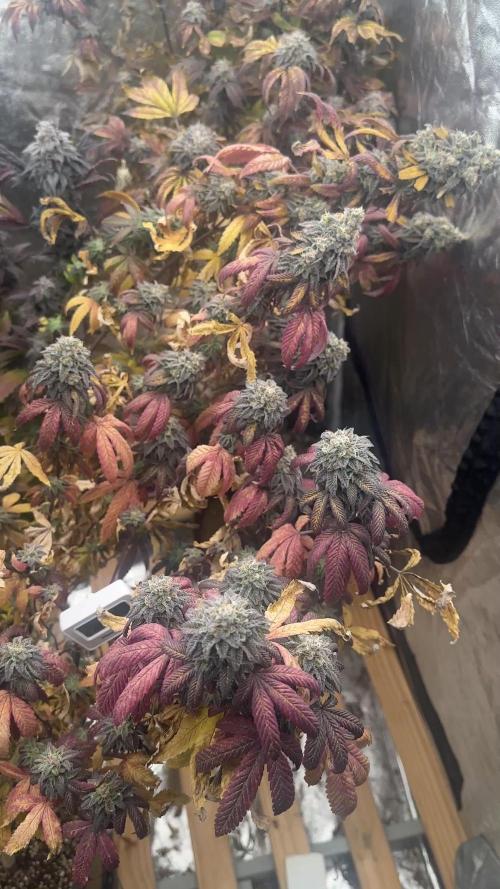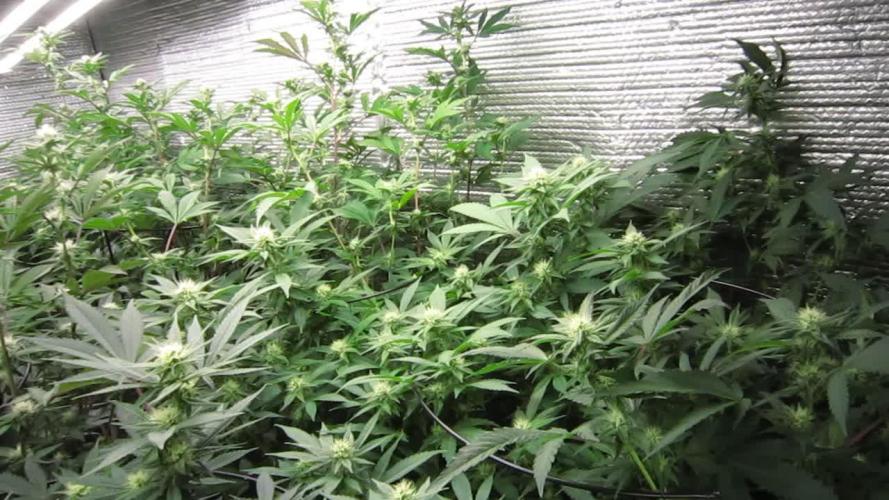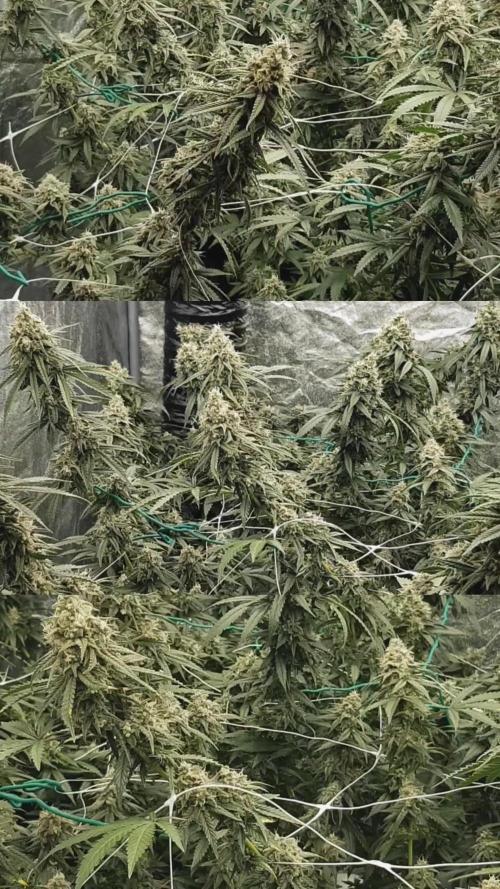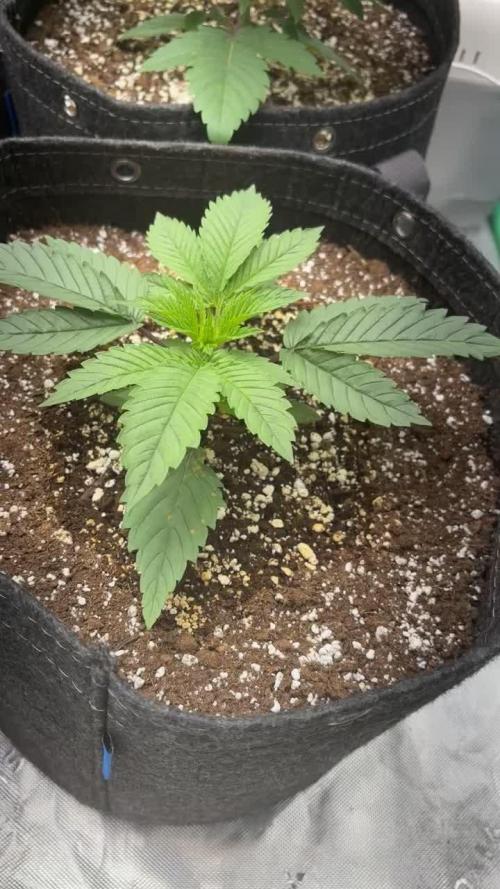The Grow Awards 2026 🏆 





























Likes
2
Share


@FrenchLivingSoil
Follow
J’ai fait une petite défoliation pour éclairer de nouveaux top. Et dégarnie l’apex centrale pour le ralentir par manque de place en hauteur.
Très bonne santé et développement des branches latérales au top
Likes
44
Share


@rudiak
Follow
Well another epic this week. The girls are looking very tasty indeed now! I have now harvested one plant on day 57. It was a tad early for her but she started looking pretty bad for some reason. Potentially started the flush on her a little early or could have been root rot. Either way the plant was chopped to ensure buds were saved. She weighed a cracking 550g wet, and dry was about 100g. This was the girl that was completely untouched, no defoliation etc complete virgin ;).
Unfortunately the RH was high I ordered a dehumidifier but they sent me a faulty one and by time had a new one was too late some mould was starting to occur on the girls in a few places. I was over cautious and slung around 25g of buds that were near the mould just to ensure it didn’t spread to the rest of the plant. I also sped the drying up and placed in brown paper bags for last 2 days to suck the remaining moisture off after a full trim and inspection. The girls took a total of 5 days to dry and are now curing. They were a bit “hay” like in smell and taste but this was probably because of all the problems listed above. She is starting to smell much better after a couple of days of curing though so my faith is restored that the remainder of the buds may be quite good still!
The last 3 girls have been going lovely, and starting to bring in some purple colours to the sugar leaves which are quite nice, all the trichomes are nice and cloudy and just starting to go amber. I will be harvesting on day 66 as this will allow me a good period of time to trim them fully into reasonable size buds and dry in my hanging net in the tent to ensure no mould problems again.
For the last 3 days I have been flushing with 30L of water to ensure they are completely free of nutrients as again think this maybe another factor on the not so nice smelling/tasting buds from the first girl. I will give 2 days to fully dry the soil out bone dry before I cut them down. Happy I took her down early as it’s allowed me to ensure I have 3 good plants left and the remainder of the grow/dry/cure should go smoothly as know what I am doing now.
Processing
Likes
1
Share


@Funkyskunky1
Follow
They are looking real good. I think I may have gotten some nutrients on one plants leaves and it caused some yellowing and leaf curl, I’m hoping it straightens out.
Likes
10
Share


@Bakeryguy420
Follow
Double grape start of week 3 of flowering another month to go :) so very excited all smiles people :)
Likes
31
Share


@crystal_garden_0
Follow
Great week. Bit of nutrient burn but nothing to worry about. Buds starting, hopefully all goes well. End of week 4. Low stress training almost daily
Processing
Likes
1
Share


@Teddy01500
Follow
Bonjour à tous, ces derniers jours ce sont bien passé pour mes petit bébés elles grandissent doucement mais sûrement.C’est la première fois que je travail avec cette gamme de produits (je vous est mis des photos des produits 😉) pour l’instant j’en suis satisfait après, il faut voir le résultat final ce qui est moins facile 😂. Mes petit bébés commence leurs 5ème semaine (je me suis trompé d’une semaine 😕 désolé 😉) trop pressé!!! 😂 de mettre de nouvelles photos 😜. Je vous dis à là semaine prochaine vivement 😉 bonne journée à tous. Je vous remercie 😉.
Likes
65
Share


@3lementa1
Follow
Things are going well. Very good root growth. The two new main stems have grown enough to be tied down for Low Stress Training. I don't think I'll top again. I want to see how fast I can get a good canopy with DWC, and see if Manifold-style training can get me a similar shape to the Mainline I did last year where I lost a ton of time from topping 4 times and doing a bunch of pruning to maintain a certain shape.
I set the lights to 18/6 to encourage some rest and regrowth, and frankly to save myself a bit of light and noise at night. The reservoir is still full so I'm going to leave it this week and change out the water next week.
The leaves are looking a bit stressed so I raised the light and moved the fan back a bit. I have a window fan pulling air out while there's no smell but I think I'll need to switch that to intake, turn on the exhaust and replace the jet with an oscillating fan. There is a fan on the cool tube for my light as well. I think I need to hang something heavier on the front to dampen the sound. All the fans are getting loud for my small apartment.
Lol I topped it again the next day. I have wires tying down all the main branches. I think it's worthwhile to spend the time in veg making a good canopy. I'm following the instructions for Nebula's Manifold technique but I haven't done any pruning yet except for the topping itself. I have a vision of what I want taking form.
June 16 I checked the pH and it was 6.5 so I brought it down to 5.5. I'm going to change out the water and nutes tomorrow. It needs a top-up so I'll just change out the whole thing tomorrow. I'm leaving out a bucket of water overnight for the chlorine to evaporate.
Likes
6
Share


@Herbman420
Follow
Hi there everybody germination is going great I've decided to run a papaya cookies I haven't done this strain yet and im curious to see how it goes. hoping to see some lovely beautiful genetics. Im doing it in coco core per lite and feeding with xpert nutrients. Thank you for tuning in there will be updates during this week on the germination have a great to grow yourself and always keep in mind it's 420 somewhere 🔥🌱👍
Likes
20
Share


@Flavors
Follow
🌸 Week 26 Update (Late Flower – Flush Time!)
We’ve officially hit the home stretch 🚀🌱. This week was all about prepping for the final push before harvest, and things couldn’t be lining up better.Both Red Hot Violet and Amaretto Sour are deep into late flower now — colors rich, pistils turning, and trichomes frosting up beautifully ❄️✨.You’re about to start the flush, and the timing is perfect:
✔️ Nutrient fade is beginning
✔️ Aromas are hitting peak intensity
✔️ Buds are swollen and dense
✔️ Leaves are naturally transitioning to harvest tones.Red Hot Violet is finishing strong with classic deep hues and tight stacking 💜🔥.
Amaretto Sour is pumping out that lemon–blueberry dessert smell even louder 🍋
Likes
1
Share


@Chucky324
Follow
Hello This is the end of week 3 and the beginning of week 4 of flowering.
Did some trimming and sucker branch removal this week.
After 3 weeks of flowering the sucker branches are obvious.
They don't reach the canopy height and they don't have flowers on them.
And anything growing down gets cut off too.
I trimmed up some of the fanleaves too.
Removed some that were blocking light from the top and thinned out some from the middle for better air flow.
There will be less chances of WPM and Bud Rot, later in the grow with better air flow now.
They will be left alone for the rest of the grow.
OK. Be Great.
Chuck.
Likes
12
Share


@Ganjawiththewind
Follow
Out of the 4 seeds only the gnarly taproot made it successfully. It is growing visually more and more everyday and soon I will investigate other two seeds that didn’t germinate and make this a one plant operation.
Likes
14
Share


@Grey_Wolf
Follow
Peyote wifi x High level again
25th October 2021
Starting to take shape now , not much much to report on this early in the grow
Thanks again for stopping by 👍
Likes
22
Share


@Polliceverde18
Follow
Ciao growers aggiornato giorno 50 do acqua ph 6.3 con EC di 1000 ų/cm più o meno
Le vedo un po troppo scure con sfumature sul viola... spero che faccia parte del suo carattere... metti like se ti e piaciuto!!!👍👍👍
Aggiornamento giorno 11/2 2 litri diviso 3 con 2 ml Rhino skin. Odore debole ma molto buono mi ricorda Amsterdam !!!
Aggiornamento 14/ 2 2,7 l diviso 3 con rhino skin bud candy e long flowering greenhouse con 1400 ų/cm e 700 ppm vorrei defogliare ma sono indeciso...🤔 Aggiunta una seconda lampada da 1000w il 13/2/21.
Alla prossima settimana ciaoo 👋👋👋
Likes
31
Share


@GERGrowDesigns
Follow
Dear Growers ,
Welcome to Flower Week 6-7 Day 42-49 from Flowering , we’re excited to share a very special project with you:
NARCOS SEEDS Kingping Kush .
With dedication, knowledge, and hands-on practice, we’ll guide you step by step through the journey—watch with us as growth, development, and small wonders unfold before your eyes.
Whether you're a beginner or an expert, you are warmly invited to join, ask questions, and share your own experiences along the way!
Project Setup & Conditions:
• Brand/Manufacturer: Narcos Seeds
• Tent: 222cmx150cmx150cm
• Light: 2x 720 Watt Full Spectrum
• Humidity: 40%
• Soil: Narcos Organix Mix
• Nutrients: Narcos Products
• pH Value: 5.6
A Special Thanks To
Narcos Seeds
for the amazing collaboration, trust, and generous support in making this project possible. Your contribution is truly appreciated!
Congratulations on Your Own Projects!
We celebrate your growth, your creativity, and the passion you bring to the table. It’s truly inspiring to witness at Each visit .
Stay curious and keep up Growing —we look forward to welcoming you back for the next chapter soon!
Likes
7
Share


@Nikkov
Follow
Well, this is the first one of flora, they already showed some pistils which are the initial sign of flora and so let's move on today I added 1ml of top bloom from top crop and let's see what happens to this grow I still think it will last a few more 8 weeks until the harvest, any questions feel free to ask or help me with something I haven't seen and I'm open to tips too! =D





















